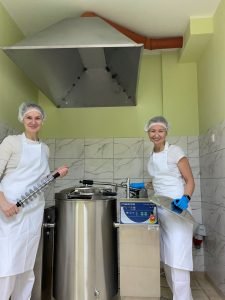The production of Karvutė (Latvian: Gotina) candy, which was very popular decades ago, is gaining momentum in the Baltics again. The Latvians are leading in this area, but Lithuanian producers are determined to catch up.
Two women have recently started a new business in the relatively small town of Rokiškis, close to the border with Latvia, reports journalist Vakaris Deksnys.
Rokiškio karvutė was founded by two young mothers, Aušra Kriovė and Simona Šulienė. Once, during a visit to nearby Biržai, a discussion took place around the table about the products that make a particular area of Lithuania stand out. And later, what Rokiškis can stand out in. The two women decided on sweets. And so the joint business was born.
In addition to a milk processing factory and an agricultural machinery factory, this Aukštaitija town was also home to the Rokiškio konservai factory. It was here that the production of such sweets began in 1969.
When the women decided to start their own business, they found Danutė Aukštuoliene, who worked as a shop foreman in the factory, and learnt the old recipe from her. It is now used to make sweets in the recently renovated workshop.
The businesswomen, who work in the administration of Rokiškis District Municipality, now have to work two jobs. And they have to work harder because there is no shortage of orders after the news of the revival of the spread of ‘Karvutė’. Especially as the local chain of shops, Lašų duona, also sells sweets representing the city.

Simona Šulienė (left) and Aušra Kriovė. Photocredits: Audrė Srėbalienė.
So far, we can say we are doing well. People call, write, we make the sweets, make the orders and send them to customers. Maybe the demand is high because it is new, maybe it will change in the future. We are still able to produce, but some shops are also asking if we can supply sweets wholesale. Unfortunately, we would not be able to fulfil such orders for the time being, said Aušra Kriovė, one of the founders of the company.
In general, Karvutė sweets are so popular that there is more than one producer in the Baltic region. Even the company founded by former Ukrainian President Petro Poroshenko, which currently operates confectionery factories in Ukraine, Lithuania and Hungary, produces them under the Korivka brand.
Latvia is particularly rich in producers, with dozens of companies in different regions reportedly producing the candy, known as Gotina, during the Soviet era, with exports to other republics of the USSR amounting to as much as 6 000 tonnes per year.
Nowadays, these sweets are produced in both Saldus and Skriveri (there are even two companies involved), as well as elsewhere.
After the 2008 economic crisis, the family of Latvians Baiba and Aigars Lūsi moved to Australia, where the husband and wife worked and the children studied. However, he didn’t stay there for too long, and when he found out that a food factory was for sale in Skriveri, he decided to return and buy it.
It had been making Gotina candy since 1956, and it was the Lūsi family who saved it from ruin. This factory was run by the same company as the one in Saldus. The company decided to keep only one of them and close the one in Skriveri. So when we came back from Australia, we bought an empty building – the equipment had already been taken out, Baiba Lūse said of her 2010 purchase.
The factory, run by the Lūsis family, employs around ten people, each of whom wraps around 4 000 sweets – about 60 kilograms – per shift. The record output per worker per day in Soviet times was 120 kilograms. That’s how many Aigars’ mother used to wrap, said Baiba. Those who couldn’t learn this job went to other production workshops, for example, to pour lemonade.
The recipe cannot be changed, Aigars, the owner of the factory, says calmly to anyone asking about the secrets of making sweets. This means that you can’t use any other kind of butter instead of fresh, or substitute brown sugar for white. If the recipe specifies that high-quality condensed milk must be used, this is what the candy must be made from. Thus, in Skriveri, the Karvutė sweets are made according to an authentic recipe from 1956. This is further confirmed by the national culinary heritage label awarded to the factory in 2015.
And competition is fierce. There is also great controversy over whose recipe is the most authentic.

Baiba and Ainars Lūši with daughter Keita. Photocredits: Audrė Srėbalienė.
The Lūsi family company publishes an interesting story on its website. Skriveru Sweets in the same city is said to make vintage sweets based on the recipe of Lizums. As competitors, they have cleverly taken the opportunity to buy our domain name www.skirverupartikaskombinats.lv, which is why, when you type in a search engine, you get their page and not ours. We have talked, we have written, we have tried to do something, but so far there is no fair and equal competition, says the family who started their business.
In Lithuania, it is simpler in this respect – there are no major disputes about the authenticity of the Karvutė sweets. Maybe they are less popular here, or maybe it’s because there weren’t as many producers in the Soviet era as in Latvia.

